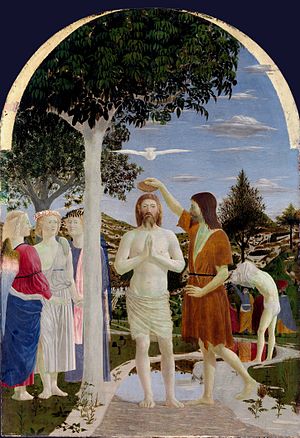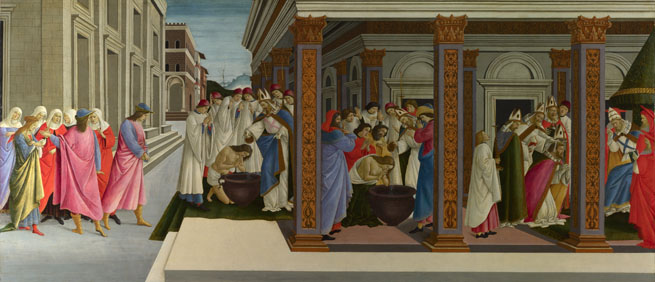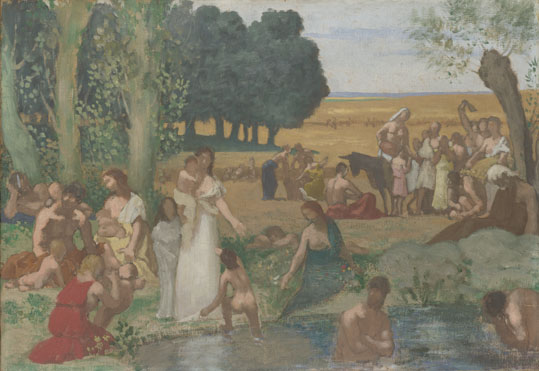Frederick Cayley Robinson: Acts of Mercy was a National Gallery exhibition created in collaboration with Tate Britainand on display 14 July – 17 October 2010.
Frederick Cayley Robinson (1862–1927) is one of the most distinctive yet elusive British painters of the early 20th century. This was the first exhibition of his work to be shown in the United Kingdom for over 30 years.
The four central paintings on display are the summation of Cayley Robinson’s artistic ambition. Executed between 1916 and 1920, his masterpiece, 'Acts of Mercy', comprises four large-scale allegorical works commissioned to adorn the new Middlesex Hospital, rebuilt between 1928 and 1935. Combining modernity with tradition to remarkable effect, the artist emulates the spiritual integrity and methods of the Old Masters he encountered in the National Gallery.
Alongside Cayley Robinson’s modern works, National Gallery paintings by

Piero della Francesca (The Baptism of Christ, 1450s),

Sandro Botticelli (Four Scenes from the Early Life of Saint Zenobius, about 1500)

and Pierre-Cécile Puvis de Chavannes (Summer, before 1873) were shown.
'The Acts of Mercy' rank as the most important decorative commissions of the early part of the 20th century, but they are also among the most singular works in modern British art. Their underlying message concerns the sanctity of human altruism expressed through medical healing and the care of orphaned children.
The two pairs are titled 'The Doctor' (1916, 1920) and 'Orphans' (both 1915).
In the former, one panel represents the traumatic effects of conflict on those invalided out of the First World War. Wounded soldiers and sailors gather in silence at the entrance to a hospital, juxtaposed by the looming presence of an equestrian statue.

In the companion piece, a doctor is thanked by a kneeling mother – echoing traditional images of the adoration or crucifixion – and the daughter he has treated.

The panels titled 'Orphans' depict the refectory of an orphanage, under the patronage of the hospital.

In one picture, girls sit at a table reminiscent of Leonardo’s 'Last Supper', while their stillness and steady gazes recall Dutch 17th-century painting.
All four works were displayed in the entrance hall of Middlesex Hospital until 2007. Subsequently purchased by the Wellcome Trust, they are normally on public display in the Wellcome Library in Euston, London. After this recent sale, the exhibition offers the chance to reassess Cayley Robinson and his stature, and also track the wide range of sources from which his work derives.
Other works by Cayley Robinson were also be shown alongside 'Acts of Mercy', including

'Pastoral' (1923–24, Tate),

'The Old Nurse' (1926, The British Museum)

and 'Self Portrait' (1898, National Portrait Gallery, London)
Cayley Robinson’s pictures are almost always of people; denizens of a silent, timeless world. A frequent theme is the care for the young and the old. Essentially a British Symbolist, Robinson created a striking variety of moods and atmosphere in his paintings to evoke complex emotional responses. His work characteristically incorporates a rich variety of altruism and symbolism, but often meaning is reserved, or implicit, creating an aura of mystery or ambiguity. There are symbolic allusions but no clear-cut messages.
The exhibition celebrated a British heritage success and provides a timely opportunity to re-examine a little-known yet highly distinctive artist who now seems to stand outside the main developments of British art. Taking the form of a modern allegory or history painting, 'Acts of Mercy' memorably explores the positive forces of the human spirit in the face of destruction.